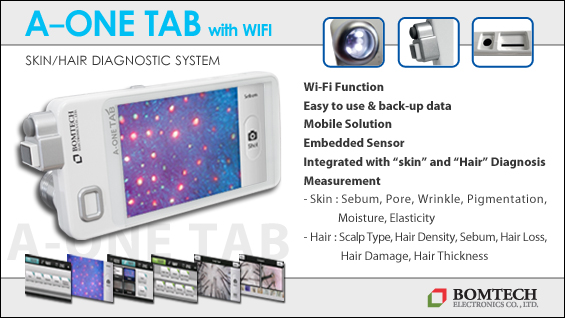Surgical removal of scar is the most fundamental method. Generally scar tissue dose not have appendages (hair follicle, sweat gland, sebaceous gland, etc.) and these appendages are not restored by other treatments. So, it is definitely a good way to try connecting normal skins by surgical removal.
However, surgical treatment has its limitations and it is very important to select an appropriate indication. In general, surgical removal may be more suitable for large scars with more aesthetic defect, while conservative methods, including laser, could be better attempted for small scars without much difference in texture from surrounding tissue, which may be more aggravated by surgery.
[Advertisement] A-One Tab with Wi-Fi(Skin/Hair Diagnostic System) – Manufacturer: BOMTECH(www.bomtech.net)
Type of scar also affects the surgical method. Complete removal of scar tissue is generally considered for atrophic or flat scar. Non-removal method, such as punch excision and punch elevation, is considered for acne scar. Complete removal is the final target for most of atrophic scars, which are considered to have low risk of recurrence or widening of lesion. On the other hand, hypertrophic scar or keloid is generally removed partially, not completely, to reduce the risk of postoperative aggravation. Postoperative conservative treatments is very important after surgery of hypertrophic scar or keloid.
Surgical Treatment of Atrophic Scar
1. Surgical treatment in acne scar
1) Punch excision, punch elevation and punch graft
Laser for skin resurfacing is generally used for the treatment of acne scar. However, punch excisions are useful for ice-pick scar, deep and narrow appearance.
2) Subcision
Subcision is a surgical technique commonly used for rolling type acne scar, but may be also used extensively for other atrophic scars that form depression by adhesion to deep tissue. Nokor needle, which has a blade attached at the end, is generally used.
2. Surgical removal of atrophic scar and flat scar
Simple resection is used when the lesion is small and the angle of the lesion is less than 30 degrees, but continuous resection is preferred for larger lesions. Continuous resection minimizes perioperative tension and does not induce discomfort such as using skin expander. Scars on upper and lower limbs, where there is a lot of tension during suture after resection, should be removed by continuous resection, if possible, to reduce the risk of side effects. During the surgery, dissection should be made sufficiently and white nylon, which has long-lasting tension for dermal suture, is recommended. Immobilization or compression should be properly applied for stabilization of the surgical site.

Figure 1. From left, ice-pick scar/ diagram of ice-pick scar/ punches of various sizes/ diagram of punch excision

Figure 2. From left, rolling scar/ diagram of rolling scar/ nokor needle/ diagram of subcision

Figure 3. Scar restoration by continuous resection
3. Special surgical techniques for scar restoration
To minimize scarring, special techniques such as Z-plasty and W-plasty are used.
1) Z-plasty
A surgical technique to switch the direction of a scar, formed in apposite direction to the resting skin tension line, to be in line with the resting skin tension line

Figure 4. Diagram of Z-plasty
2) W-plasty and Geometric broken line plasty
A surgical method to remove scar and make tensions coming from various directions. This method is used for scars too long or those located on sites where simple suture would cause too much tension.

Figure 5. W-plasty and Geometric broken line plasty
- To be continued-
▶ Previous Artlcle : #6. Laser for Scar Treatment Ⅱ





















